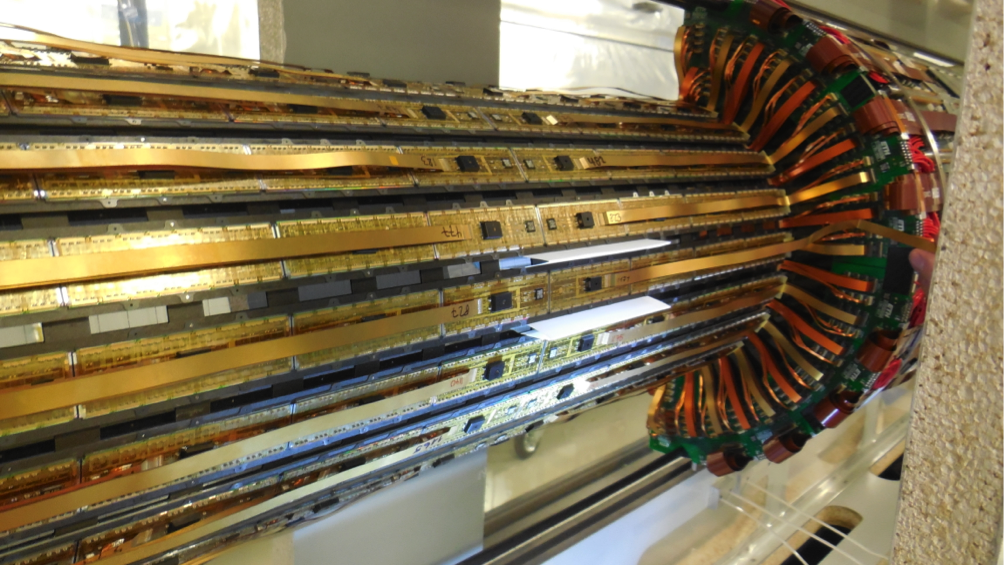
During Long Shutdown 1 (LS1), that started in 2013, both the forward Pixel (FPix) and the barrel Pixel (BPix) detectors were extracted from inside CMS for maintenance, in order to recover the broken channels. The extraction took place on May 2nd and 3rd 2013 and lasted one and a half days for each of the the forward and barrel Pixel detectors. After extraction, they were lifted to the surface, placed in a clean room at Point 5 and stored in dry boxes at a temperature below 10°C to mitigate the effects of radiation damage. Repairs started at the end of May 2013 for the FPix and in November 2013 for the BPix.
About 7.8% of the FPix channels were not operational during data taking. There were different kinds of failures: for 3.6% of the FPix readout channels, the analogue signals could not be digitized by the back-end electronics due to distortions in the signals themselves; for 3.1% of FPix (6 panels), the electrical-to-optical converters (AOH), the devices responsible for transmitting data to the FED, had become unplugged; and for 1.1% of FPix there were problems in the sensors, rendering them inoperable.
In addition to these faulty channels, about 7.7% of the detector channels showed intermittent problems during data-taking or were made to function thanks to workarounds: in one sector (3.1% of the detector) instabilities in the programming of the Read Out Chips (ROCs) were observed; 6 panels (3.1%) had a disconnected low-voltage sense wire, while 3 other panels (1.5%) showed very noisy signals related to dirty optical fibers on which the data are sent to the FED.
All these failures have been investigated, understood and fixed during LS1. Distorted signals were found to be related to a poor connection between the high density interconnect (carrying the analog electrical signal from the sensors) and the AOH. ROC programming problems were found to be linked to a faulty connection as well: in this case, the bad connection was between the digital optical-to-electrical converter (DOH) and the interconnect cable carrying digital commands and low voltage to the sensors. In both cases the interconnect cables have been replaced with new ones and, after replacement, the operation of these sectors has been tested extensively over long time periods. The sense wire problem as well was related to a misplacement of high density interconnect carrying the digital signals; this was finally replaced along with the circuit board to which it was connected.
In October 2013, a team of technicians from Fermilab successfully replaced three panels which were not working and that could not be repaired. The same team prepared the installation of the Phase I Pixel pilot blade system, the system that will test the Phase I Pixel readout during 2015 and 2016 running. They installed a third half disk mechanics in two, out of four, half cylinders that are going to host the new Phase I modules that will be installed in July 2014.
The FPix repair work was completely successful and led to the full recovery of all malfunctioning channels, with the exception of only one ROC (corresponding to 0.02% of the FPix detector). This ROC belongs to a portion of the detector where no other repair work was planned. Since the replacement of a panel necessitates a delicate sequence of operations, it was considered that such a repair would not be safe for the rest of the system.
The fraction of malfunctioning BPix channels was about 2.3%. All these channels were excluded from operations during Run I. The source of all failures was identified as broken wire bonds. The tight-fitting three-layer structure of the BPix detector, with modules placed on both the inner and the outer faces of each layer, makes accessing most modules difficult. Thus, it was decided to replace only the modules placed on the outer face of the outermost layer, Layer 3, which is the most easily accessible region of the BPix. This decision was taken in order to avoid any risky actions that could potentially damage the detector. In addition some faulty services were found, which could be repaired during LS1.
Eight BPix inoperative modules, all placed in Layer 3, were exchanged. Each new module was tested twice before the insertion into the barrel: at PSI and again in P5, to make sure that transportation hadn’t caused any damages. Despite the awkward procedure, the team of experts was able to replace the eight modules and decreases the fraction of inoperative BPix channels by almost a factor of two, bringing it from 2.3% to 1.3%.
In addition to the faulty modules two AOHs were not working properly due to disconnected wire bonds between the laser and the AOH print. The replacement procedure is a delicate operation, the most critical step being the connection and disconnection of the AOHs from the supply tube. In order to substitute one AOH, all the others placed in the outside direction with respect to the broken one must be unplugged as well.
Thanks to the competence and dedication of all the people involved, all repairs were completed successfully. A strong team of engineers, technicians and physicists from several institutions has contributed to the maintenance effort in a timely manner. The same team will soon face the task of re-inserting the CMS Pixel detector at the core of the CMS experiment just around the luminous region.
By Annapaola De Cosa and Martina Malberti
- Log in to post comments

